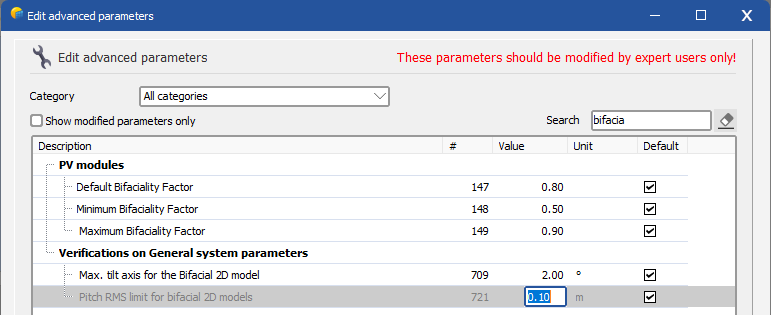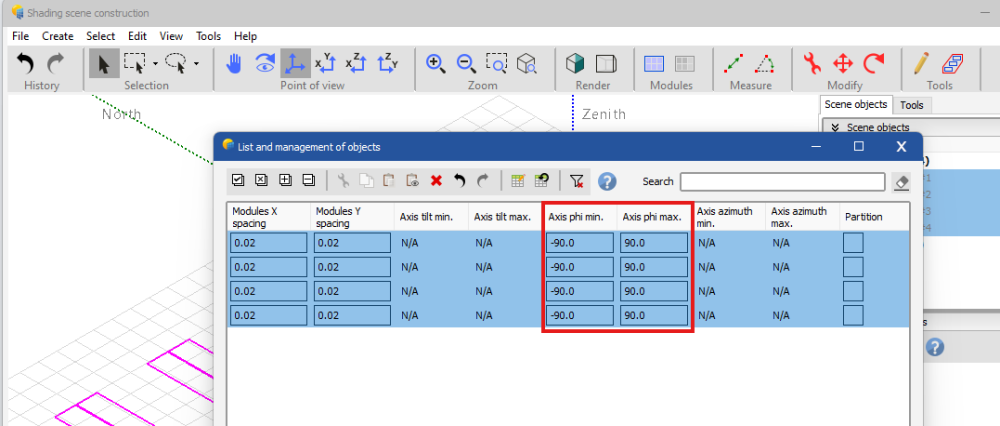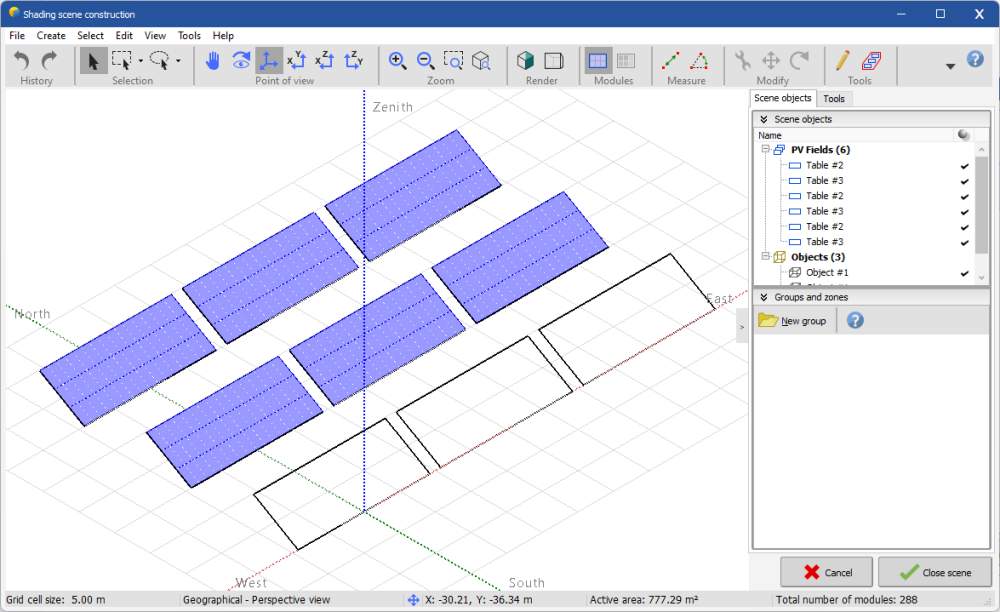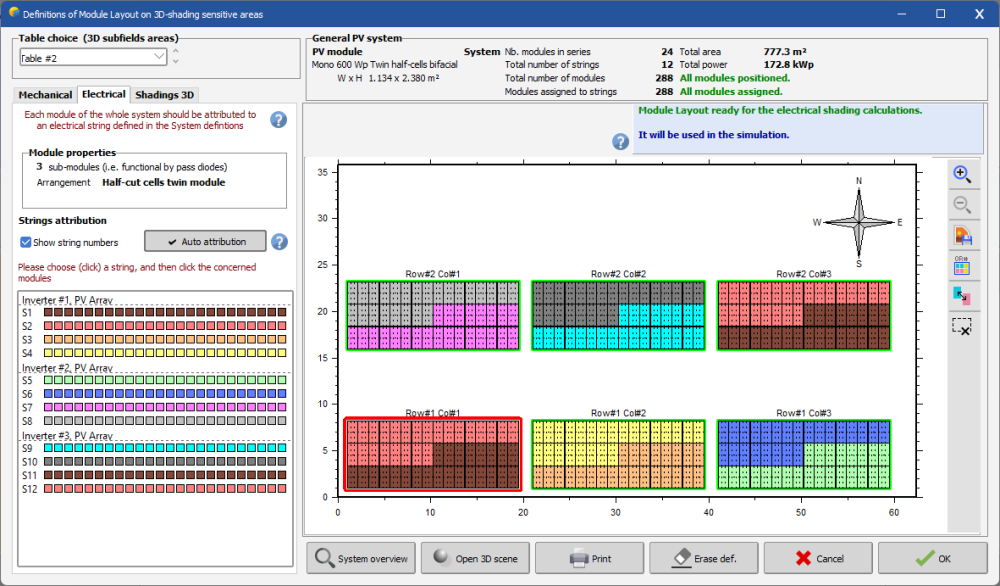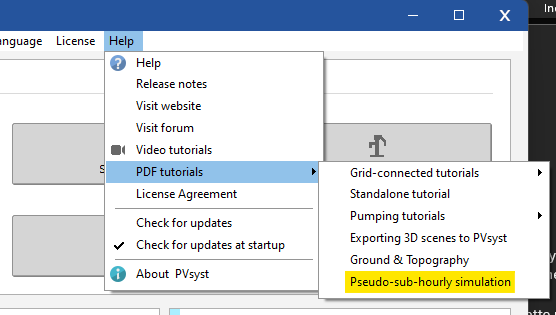-
Posts
793 -
Joined
-
Last visited
Everything posted by Michele Oliosi
-
Hi, not sure what you mean by using a CSV to build the 3D scene. Could you send your project at support@pvsyst.com? We would then be able to look at the 3D scene. In any case, take a look at 3D scene → Tools → Backtracking management. There you can verify the backtracking parameters.
-
Hi ! Actually, you do not need to have an "array of tables" in the 3D scene to apply the bifacial model, but there are a few regularity requirements that have to be met: https://www.pvsyst.com/help/bifacial-conditions.htm However, it cannot be expected that you modify the pitch of your plant just to run the simulation. For that reason, it is possible to modify the threshold for the activation of this error. Since this error stems from the evaluation of the standard deviation on the pitch distribution, the threshold can be changed in the advanced parameters : Home window > Settings > Edit advanced parameters: Please be aware that while this won't modify the results of the simulation, it will allow you to simulate a situation in which the bifacial model (which is a regular idealization using the average pitch and table size values) will not fully represent the complexity of the 3D scene. However, usually, unless you have a very strange setup, the error from this discrepancy is minimal.
-
There is a problem with the trackers created by zones. These end up having +-90° of maximum and minimum rotation angles. To correct this, once you created all trackers, you can either go to Tools > List and management of objects, or simply press CTRL+G in the 3D scene. There, you can find the column with the min / max phi and edit them to be compatible with the orientation.
-
@Loïs Masson Yes it is possible to use partitions with a non-rectangular PV table. Honestly, with non-conventionally wired modules such as the voltec ones, there are no other solutions with the current PVsyst version. Finding equivalent modules, to run the module layout calculation, and using that to adjust the results of the partition calculation, as suggested at the beginning of the thread, seems like a reasonable idea.
-

Partitions for 1 Portrait Half cut cell Tracker
Michele Oliosi replied to Aidenn's topic in Simulations
yes you got it, x = 2 (because half-cut) and y = 3 (# of strings) -
The partition tool is not really adapted to this kind of situation either. For irregular shadings, it tends to overestimate the losses. I would suggest changing the parameter "Fraction for electrical effect" to about 20 %. This will reduce the electrical shading loss so that it has about the same magnitude as the jinko modules. I did not go as far as setting a 10% fraction because it is better to be very conservative in this case.
-
This is normal, since PR is defined normalized by the front-side POA irradiance (GlobInc) but bifacial modules can also capture light from the back. The PR of bifacial projects is oftentimes > 1. There are more details on this help page: https://www.pvsyst.com/help/performance_ratio.htm Regarding the negative Global Incident, this is also normal, because it accounts for the front side irradiance relative to the horizontal plane. If you just look at the front-side, there is more irradiance on a horizontal plane than on a vertical plane. This is of course more than compensated by the backside irradiance part of the loss diagram.
-
The Global incident will be negative if the orientation is worse than the horizontal fixed plane. I am not sure why, just from your text. Indeed, in principle, trackers should have a better transposition than a fixed plane. It is difficult to answer just from the loss diagram and 3D screenshots. Could you export your project and send it to support@pvsyst.com ?
-
In your top question, the shadings are not exactly the same. Are you using the fast (relying on interpolations, which are sensitive to tiny rounding differences) or slow method ?
-
EW trackers here can follow the sun closely in the morning and evening. Instead, fixed tilt does not have a good orientation in the morning and evening.
-
Hi, this is a complicated question. The partition model is really ill-fitted to this kind of arrangement. The best is to model this first with the module layout: In this situation (GCR, tilt, climate, inverter layout, type of modules) this gives me about 0.9% electrical shading losses. If I then wanted to replicate this in the partition model, it is best to proceed by trial and error. Here defining 3 partitions in Y and 1 partition in X seems to work best to replicate the same amount of electrical shading losses. I tried first Y = 6, but the electrical shading losses were too small. In summary, it is hard to define how to partition in this kind of situation, and it will depend a lot on many factors. It is best to check with a simplified layout in the module layout to make sure that the partitioning gives a good amount of losses.
-
Half-cut cell modules in portrait, strung in U (2TU) have: - Partitions in y = 2, partitions in x = 1 For wider tables which are 2 strings across (26 = 2*13) still strung in U: - Partitions in y = 2, partitions in x = 2 https://www.pvsyst.com/help/shadings_partitioninstrings.htm
-

I have a question about using Simulation parameters.
Michele Oliosi replied to somkiat chamsakorn's topic in How-to
Please read the highlighted tutorial.. -
Hi, First, please understand that the partition model is an approximation that is well-defined in the case of simple rows of tables or trackers, with topographies that are quite regular. In the case of other irregular situations, such as your figure 6 and the discussion about figure 4, the usual rules from the help page do not apply. You can choose to use the partition model differently than the intended partitioning, as you did, but this should be done very carefully. I think you are correct in decreasing the number of partitions when shadings are irregular; this is the more conservative approach. Regarding figures 3 and 5, I agree that a partition in X is missing. Indeed, it should be X = 2, to differentiate the different strings. We will correct these images asap. Regarding figure 1, I do not agree with your comment. Indeed, in the case of regular rows, the effects of by-pass diodes and diffuse fraction accounted together are best modeled by Y = 2. Even if there are multiple strings on a given MPPT, as long as they are all shaded in the same way, the effect is the same as having one string by MPPT.
-

I have a question about using Simulation parameters.
Michele Oliosi replied to somkiat chamsakorn's topic in How-to
This is not possible directly from a single PVsyst simulation (which is in hourly steps). But you can run multiple simulations to approximate sub-hourly results. In version 7.4.8 we added a tutorial for this procedure because it is a bit technical. You can find this tutorial here: -

Median P50 AC Energy vs. AC Energy Injected into the Grid
Michele Oliosi replied to kjs55's topic in Suggestions
You have 1% "climate change" this parameter will make P50 and E_Grid(Sim.) differ. It represents the fact that the weather data used for the simulation is not representative for the P50 (e.g., the P50 may change in the future, or has changed since the data was recorded). -

Energy production not following yearly irradiance pattern
Michele Oliosi replied to Aina's topic in Simulations
If you look at the irradiance on the plane (GlobInc) you can see that it is fairly similar throughout the year. The chosen orientation is giving a push to the production in winter. -
This is because clipping is handled by displacing the working point on the input IV curve. This causes the clipping losses. Of course, we do make any needed conversions from inverter nominal power (AC) to the corresponding DC power.
-

Not matching GCR for backtracking and average GCR
Michele Oliosi replied to ali's topic in Simulations
By default, the backtracking algorithm will find the lowest pitch in your scene (hence the highest GCR) as reference for the backtracking motion. This is what is indicated in this message, and it means that some trackers in your scene are slightly closer to each other than the others. This may be due to how the row distance was calculated in your initial layout. In any case, this is not really a problem, but more of an information. You can, if you want, adjust the backtracking settings in 3D scene > Tools > Backtracking management. -

Near Shading Losses Vertical E/W system
Michele Oliosi replied to RobertH's topic in Shadings and tracking
Hi, this is actually related to the albedo component. You can check that by setting the project settings albedo to a lower value. This will in principle decrease the near shadings proportionally, if the pitch is large enough for mutual shadings to be negligible. Note that albedo shadings are extrapolated from the shadings at the lowest sun height, so they are very sensitive to having another row, even very far. In the case of a bifacial system, I would not be too worried, because the loss of albedo due to mutual shadings is in principle mostly compensated by the ground reflection on the front side. This latter contribution is present in the case of the bifacial model being activated. -
Yes, it is okay to relax the corresponding thresholds. Indeed, there is no alternative, currently. However, please be aware that the uncertainty will depend on how good the “average geometry” is a good approximation. The averaged orientation is currently an average of the axis azimuths and tilts, done separately. This works well for small angle differences, but is not so robust for large differences in either tilt or azimuth. For fixed tilts, the same is true for the plane azimuths and tilts. Modifying the tilt limitations does not increase the uncertainty per se. What increases it is if the 3D scene is a situation that does not match the “average geometry” well. We do not have any general use tools to estimate the increase in uncertainty related to the averaging, at the moment.


